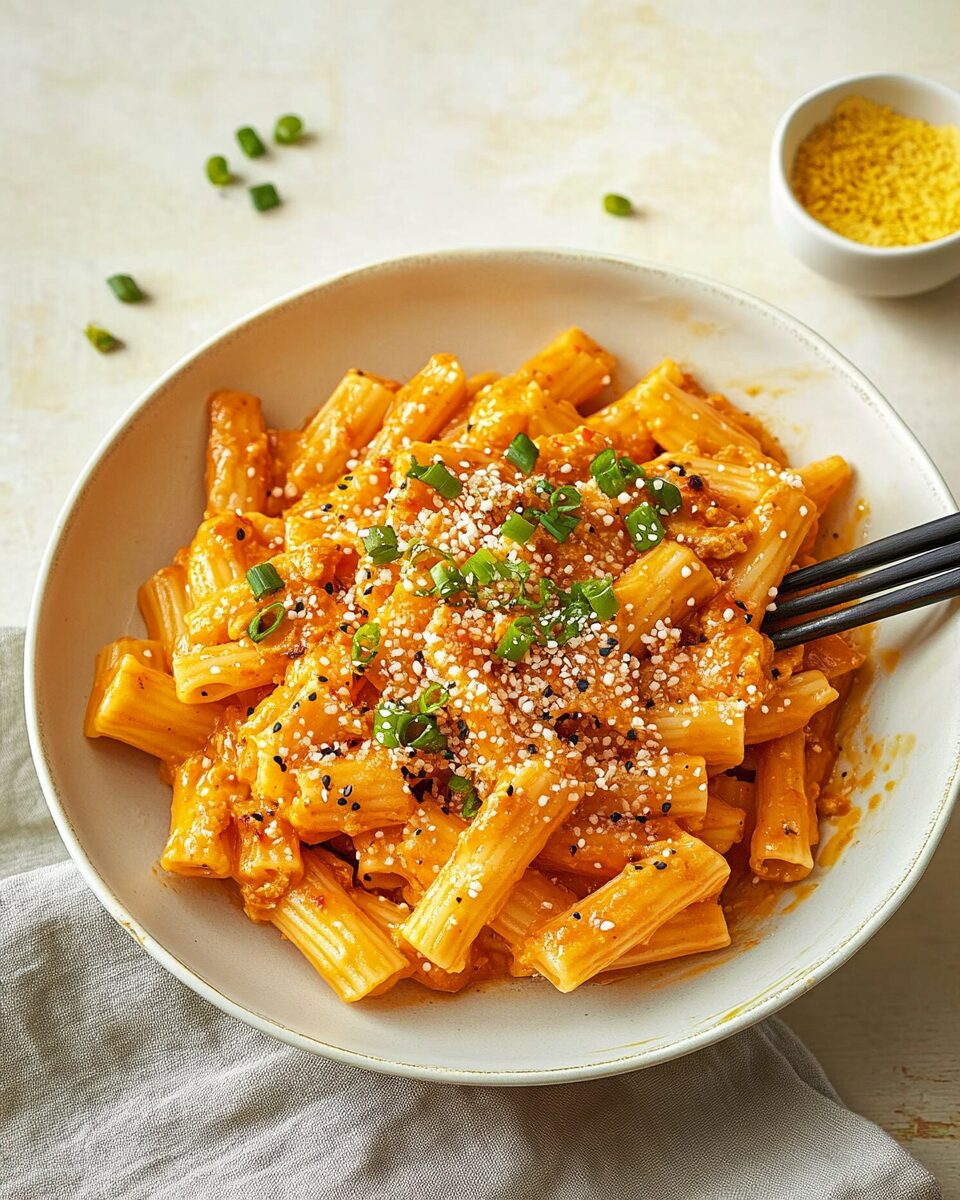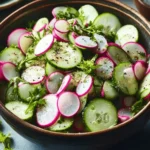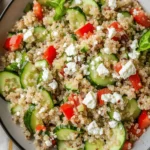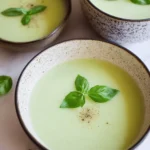Gochujang Pasta is a delightful fusion dish that combines the comforting elements of Italian cuisine with the bold, spicy flavors of Korean gochujang paste. This creamy and savory pasta is quick to prepare, making it an excellent choice for a weeknight dinner or a special meal.
FULL RECIPE:
Ingredients
- 200g rigatoni or pasta of choice
- 1 tablespoon olive oil
- 2 cloves garlic, minced
- 1 beef stock cube
- Salt, to taste
- 1-2 tablespoons gochujang paste (adjust based on desired spice level)
- 100g cream cheese
- 50g grated Parmesan cheese
- 2 spring onions, finely chopped
- Dried parsley, for garnish
Directions
- Cook the Pasta: Bring a large pot of salted water to a boil. Add the pasta and cook until al dente, following package instructions. Reserve ½ cup of pasta water before draining.
- Prepare the Sauce: In a large pan, heat olive oil over low heat. Add minced garlic and sauté until fragrant. Pour in the reserved pasta water, crumble in the beef stock cube, and add a pinch of salt. Bring to a boil.
- Incorporate Gochujang: In a small bowl, dilute gochujang paste with a bit of hot pasta water. Stir this mixture into the boiling pasta water in the pan.
- Combine Pasta and Sauce: Add the cooked pasta to the pan, stirring to coat evenly. Reduce heat to low.
- Add Creaminess: Stir in the cream cheese until melted and the sauce becomes creamy. If needed, add more pasta water to achieve desired consistency.
- Finish with Cheese: Turn off the heat and mix in grated Parmesan cheese and dried parsley. Season with black pepper to taste.
- Serve: Garnish with finely chopped spring onions and an extra sprinkle of Parmesan. Serve immediately.
Nutrition Facts
- Calories: 580 kcal per serving
- Carbohydrates: 81g
- Protein: 10g
- Fat: 19g
- Saturated Fat: 10g
- Fiber: 3g
- Sugar: 4g
Origin of Gochujang Pasta
Gochujang pasta is a contemporary fusion dish that combines the bold and spicy flavors of Korean gochujang with the creamy richness of Italian pasta. While gochujang has long been a staple in Korean cuisine, used in stews, marinades, and sauces, its adaptation into a pasta sauce has gained popularity as global palates embrace fusion cuisine. The dish highlights the versatility of gochujang, adding a spicy kick that enhances the creamy texture of the sauce. The use of gochujang in pasta is a nod to the growing influence of Korean ingredients in Western kitchens, reflecting the seamless blend of culinary traditions.
Popularity and Cultural Significance
Gochujang pasta has become a favorite among food enthusiasts seeking bold flavors and simple preparation. Its appeal lies in its ability to transform a classic pasta dish into something unique and memorable. Social media platforms are filled with home cooks and professional chefs showcasing their versions of the dish, often adding personal touches like vegetables, proteins, or garnishes. The visual appeal of the vibrant red sauce, created by the gochujang, further enhances its allure. Additionally, this dish has become a symbol of culinary experimentation, celebrating the fusion of East and West. Its popularity has also encouraged the wider availability of gochujang in mainstream grocery stores, making it more accessible for home cooking.
Flavor Profile and Texture
The flavor of gochujang pasta is a harmonious balance of heat, sweetness, and umami. Gochujang paste, made from fermented chili peppers, soybeans, and glutinous rice, imparts a rich and complex flavor. When combined with creamy ingredients like cream cheese or heavy cream, the heat of the gochujang is mellowed, resulting in a sauce that is both bold and comforting. Parmesan cheese often adds a savory depth, while the addition of garlic enhances the overall flavor. The sauce clings to the pasta, providing a smooth and luxurious mouthfeel. The final dish is often garnished with fresh herbs or green onions, adding a pop of color and a hint of freshness.
Variations and Customization
One of the key reasons for the popularity of gochujang pasta is its adaptability. Home cooks can easily customize the dish by adjusting the level of spice or incorporating different proteins. Chicken, shrimp, or tofu are common choices that complement the creamy sauce. Vegetables like spinach, bell peppers, or mushrooms can be added for extra texture and nutritional value. For a more indulgent version, additional cheese or a splash of heavy cream can enhance the richness. Alternatively, those seeking a lighter option can substitute cream with Greek yogurt or a dairy-free alternative. The versatility of gochujang pasta ensures that it can be tailored to suit various dietary preferences and spice tolerances.
Presentation and Serving Suggestions
Presentation plays a significant role in enhancing the dining experience of gochujang pasta. The vibrant red hue of the sauce creates a visually striking dish that is sure to impress. It is often served in a shallow pasta bowl, garnished with freshly grated Parmesan cheese, chopped green onions, or a sprinkle of sesame seeds. For an extra layer of flavor, a drizzle of sesame oil can be added. Pairing the dish with a simple green salad or garlic bread balances the richness of the sauce. Additionally, a glass of crisp white wine or sparkling water with lemon complements the spicy notes of the pasta, creating a well-rounded meal.
Health and Nutritional Considerations
While gochujang pasta is undeniably indulgent, there are ways to make it a more balanced meal. Using whole wheat or legume-based pasta increases the fiber content, making the dish more satiating. Reducing the amount of cream and cheese or opting for low-fat alternatives can also lower the calorie content. Gochujang itself contains beneficial probiotics due to its fermentation process, which supports gut health. For those with dietary restrictions, the recipe can be easily modified using dairy-free cheese and cream substitutes. Additionally, incorporating lean proteins and vegetables enhances the nutritional profile of the dish, making it a wholesome choice for any occasion.
Popular Occasions and Uses
Gochujang pasta is well-suited for a variety of occasions. It is an excellent choice for a quick weeknight dinner, as it can be prepared in under 30 minutes. Its bold flavors and elegant presentation also make it ideal for entertaining guests or serving at dinner parties. Additionally, the dish can be customized for festive occasions by adding luxurious ingredients like lobster or truffle oil. For casual gatherings, it pairs well with side dishes such as roasted vegetables or a fresh cucumber salad. Leftovers can be stored and reheated, making it a convenient option for meal prep.
Conclusion
Gochujang pasta exemplifies the beauty of culinary fusion, blending the spicy, umami-rich flavors of Korean cuisine with the comforting creaminess of Italian pasta. Its rise in popularity reflects the growing appreciation for global flavors and the willingness of home cooks to experiment with new ingredients. Whether enjoyed as a simple weeknight meal or served as a centerpiece for a special occasion, gochujang pasta delivers a satisfying and memorable dining experience. Its adaptability and bold flavor profile ensure that it will remain a favorite in kitchens around the world, celebrating the best of both culinary traditions.






